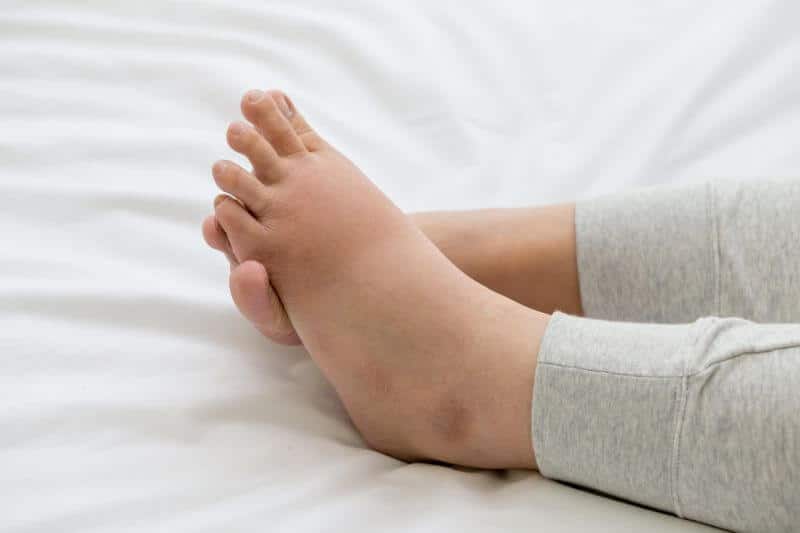Having swollen feet and ankles is a common problem, especially at this time of year when temperatures are climbing. The swelling is caused by an accumulation of fluid: you might hear your podiatrist refer to this problem by its medical name, oedema. You develop oedema if fluid leaks from tiny blood vessels called capillaries into the surrounding tissue. Your feet and ankles are particularly prone to swelling due to the effect of gravity – it’s difficult for your circulatory system to carry the build-up of fluid away from these areas.
When your feet and ankles are puffy, the skin may look overstretched and shiny. The swelling makes you feel uncomfortable and stiff, so it’s more challenging than usual to be active. Your normal shoes and hosiery could well get too tight, in which case wearing them may lead to blisters and sores.
Swollen Feet and Ankles – Common Causes
- Hot weather – blood vessels expand, allowing heat to escape in order to help you cool down. However, fluid can easily escape too and flood your tissue.
- Sitting or standing for long periods – being stationary leads to poorer circulation and fluid pooling in your feet and ankles.
- Being overweight or obese – excess weight puts your lower limbs and circulation under strain, which makes fluid build-ups more likely.
- Ageing – as you get older, your circulatory system gets weaker. You’re therefore more susceptible to swollen feet and ankles.
- Eating too much salt – as the British Heart Foundation points out, adults should consume less than six grams per day to help protect their circulation. Consuming too much disrupts your normal salt/water balance; your body tries to compensate by holding onto more fluid than it should.
- Side effect of some medications – you may develop oedema when taking certain prescription drugs, such as steroids and blood pressure tablets.
- Pregnancy – an expectant mother’s body retains more water than usual, while the weight of the baby can impair the circulation in her lower limbs, making swollen feet and ankles more likely.
Tips for Reducing the Swelling at Home
There are various ways you can try to relieve swollen feet and ankles. The aim is to boost your circulation and encourage blood vessels to reabsorb the fluid and carry it away.
- Raise your feet and ankles a little above heart level – you could lie down and rest them on pillows for half an hour. Gravity will help to move the fluid.
- Massage swollen areas – apply light pressure, working upwards from your feet.
- Try gentle exercise – lie on an exercise mat, raise your legs and make a pedalling motion, as if you’re riding a bike. Swimming can help too.
- Enjoy a footbath – place your feet and ankles in a bowl of warm water and Epsom salts to soothe them and improve blood flow. (Please note: diabetics shouldn’t soak their feet.)
- Take regular breaks if you have to stand or sit for long hours – ideally go for a walk.
- Reduce your salt intake, if you consume more than six grams per day, by avoiding foods such as crisps, microwave meals and cooking sauces.
- Stay well hydrated – drink about two litres of water per day. Your body ends up holding onto more fluid than it should if you’re dehydrated.
- Wear comfortable, breathable shoes – this isn’t the time to be squeezing your feet into impractical footwear. You may need slightly bigger socks – wear some that cool feet by wicking away sweat.
Expert Help for Foot and Ankle Swelling
At-home remedies can help you to manage foot and ankle swelling, but if the problem lasts more than a few days or you find it very frustrating, do see our podiatry team at one of our London foot clinics for a professional examination, advice and treatment. We can also help you to decide if compression socks (which can prevent further episodes of swelling) are right for you.
It may be the case that the swelling is a sign of an underlying health problem; for example, an injury, infection, blood vessel damage or Charcot foot. So it’s important that you get professional help.
There’s a small chance that foot and ankle swelling points to a life-threatening condition such as a blood clot. If the swelling is sudden and severe, is accompanied by other symptoms such as pain or affects only one side of the body, seek emergency medical assistance.
But please keep in mind that such emergencies are relatively rare and oedema can usually be managed at home and with help from your podiatrist.
For expert help with foot and ankle swelling, book an appointment with Feet By Pody today.

